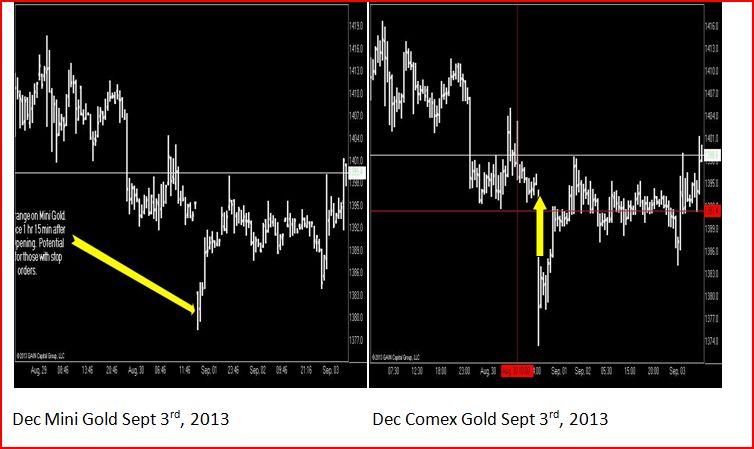Mini futures contracts—some concerning things may come in small packages.
For all their successful attributes, there are mini futures contracts which appear to have failed to live up to exchange expectations and in some cases contain elements that will offer significant challenges to a trader’s ability to enter, manage, or exit a position.
The genesis for my writing this was a Futures magazine article I read touting the advantages of mini and micro contracts for experienced and new traders in futures and recently stock options. Highlighted benefits included traders with lower capital to participate in the markets, more flexibility to build positions that can be rolled into full sized contracts in order to take delivery of the underlying commodity, and the ability to tailor risk profile and hedging by having smaller contracts to create closer matches to existing cash positions in financials and commodities.
In my nearly 20 years experience on institutional and retail futures trading desks, I have seen clients experience the mini contract benefits stated above. The S&P 500, NASDAQ, and JGB (Japanese government bond) are examples of futures contracts that developed successful mini versions of themselves, even eclipsing their originating contracts in trading volume.
However, before considering using mini or micro contracts, a study that examines these contracts using the criteria listed below can be extremely helpful to determine suitability.
TRADING VOLUME
The measure of success and likely liquidity of a futures contract can often be most easily measured by its trading volume. While E-mini S&P and NASDAQ contracts are extremely liquid, mini contracts for metals, currencies, and energies are often just a fraction of the trading volume of the larger contracts. This can often translate into larger spreads between bids and offers as well as slippage issues for resting stop orders. Below are percentage comparisons of some minis to their parent contracts.
Estimated average volume comparisons- mini crude 2.9% of crude oil, mini natural gas .005% of natural gas. NY mini gold .002% of gold (The liquidity on the Comex NY mini gold contract is so lacking that most traders make use of the NY LIFFE mini gold metals contracts.
DIFFERENT OPENING AND CLOSING TIMES FOR MINI CONTRACTS
A recent uptick in market volatility has brought more attention to this issue. Below are two charts: one showing the Sunday opening for Comex gold and the other the NY LIFFE mini gold contract.
There is a significant difference in the opening ranges between the two. This is caused by the fact that the mini contract opens one hour and 16 minutes later than the Comex contract. The effectiveness of using the LIFFE mini contracts for gold and silver is diminished, particularly if a trader has a resting order type such as a stop or stop limit in the system which is violated by price action in the COMEX contract.
For traders using stop orders to enter or exit trades, this can result in significant losses due to the inability to act on the orders during that closed period where gold futures are trading. This is the same issue that many ETF’s (exchange traded funds) that track the S&P have when compared to the E-mini S&P futures. A second in the futures markets can seem like a lifetime, imagine what an hour and sixteen minutes of inability to access can offer.

Charts: courtesy of Open E Cry, A division of Gain Financial LLC.
NO STANDARD CONTRACT OR MARGIN SIZE FOR THE TERM “MINI”
Even among market sectors, there is not a set size for a mini contract. A trader needs to be aware that in the energy sector, the mini natural gas (QG) contract is a quarter of the size of the full size (NG) contract. Crude oil, RBOB gasoline, NY ULSD heating oil mini contracts are one half the contract size. Margin levels on minis may not have a direct size correlation to the full contract. A trader expecting to be charged one fifth initial margin for a mini silver contract maybe surprised when the expected margin is higher. This can be done on the exchange or clearing house level.
THE BOTTOM LINE
Traders should be aware that the effectiveness of mini contracts to offer greater access to the futures markets must be thoroughly measured to determine suitability. In some cases, the lack of liquidity or in some cases denial of market access may result in even greater challenges to trader’s abilities than the volatility caused by higher tick values of full sized contracts.
Disclaimer: The information and opinions contained herein comes from sources believed to be reliable, but are not guaranteed as to accuracy or completeness. The risk of loss in trading futures and/or options is substantial. Each investor must consider whether this is a suitable investment. When trading futures and/or options, it is possible to lose more than the full value of your account. All funds committed should be risk capital. Past performance is not necessarily indicative of future results.
= = =
Have you had good/bad experiences with mini contracts? Share your thoughts below.




